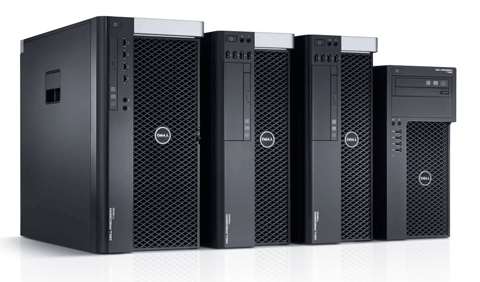
Dell’s new workstation family (from left to right) the Precision T7600, Precision T5600, Precision T3600, and Precision T1650.
In sunny San Francisco last week Dell pulled back the curtain on its long awaited Xeon E5-1600/2600-based Precision workstations.
Gone was the trademark silver facade – in its place a sleek black honeycomb grill, minimal in terms of its design, but hiding an incredibly functional aluminum chassis and buckets of processing power inside.
This is arguably the biggest redesign in the history of Dell Precision workstations. The entire chassis has been developed from scratch, driven by a key requirement for increased serviceability, though functionality, styling, improved airflow and reduced fan noise also had a major influence.
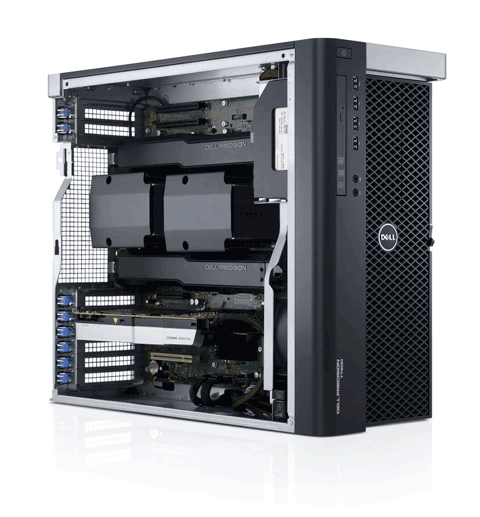
Interior of the new Dell Precision T7600: uncluttered, well organised and easy to service – the near side features access to CPUs, memory and graphics, while the rear side houses hard drives and PSU.
There are a number of innovations in the new look Precision – a power supply that can be pulled out from the back, front accessible hard drives, and a tool-less chassis, all designed to minimize downtime should a key component fail. The new Precision range also features a patented memory technology designed to eliminate errors by extending the capabilities of workstation-class Error Correcting Code (ECC) memory.
Workstations specifications
The new workstations are built around Intel’s new ‘Sandy Bridge’ Xeon with the 8 core Xeon E5-2687W taking centre stage in the dual socket Precision T5600 and Precision T7600. Intel’s new chip can be partnered with up to 64GB, 128GB and 512GB of 1600MHz or 1333MHz ECC RDIMM memory in the T3600, T5600 and T7600 respectively. Most CAD/CAM/CAE users won’t even get close to filling these.
All the new Precisions feature a choice of Nvidia or AMD graphics cards, with the dual socket Precision T7600 supporting three high-end GPUs, including the Nvidia Quadro 6000 and Nvidia Tesla 2075 GPGPU (General Purpose GPU) and Nvidia Maximus technology. This gives Dell an advantage over the other Tier One workstation vendors, who only support two GPUs. But don’t get too excited. In design/engineering workflows, the benefits of having two Tesla cards are likely to be restricted to GPU-enabled rendering applications such as Bunkspeed Shot and 3ds Max. GPU-enabled simulation software, including Abaqus and Ansys, can currently only make use of a single Tesla card, though this is likely to change in the future.
In terms of storage, the Precision T7600 can support a colossal eight drives – SATA, SAS or SSD – aimed at users of Digital Content Creation (DCC) or design viz software. The Precision T5600 and Precision T3600 still offer capacity for four, which should be plenty for most design and engineering workflows. All the usual RAID standards are support for performance or redundancy including 0, 1, 5, 10.
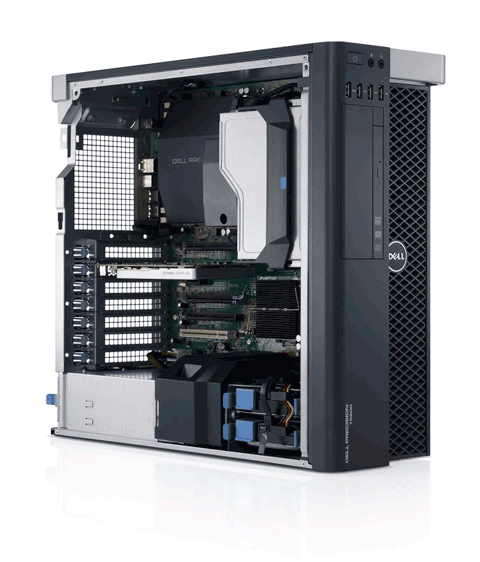
The Precision T5600 and the Precision T3600 share the same chassis. It’s not as wide as the Precision T7600 because the hard drives and PSU are all housed along with the other components. This also means the hard drives can only be accessed by removing the side panel and not from the front.
There are four new additions to Dell’s Precision family.
Dell Precision T7600 (high-end dual socket)
One or two Intel Xeon E5-2600 family processors
Up to 512GB 1600MHz or 1333MHz ECC RDIMM quad channel memory
Up to three high-end GPUs, including Quadro 6000, AMD FirePro V7900 and Nvidia’s Tesla C2075 GPGPU (plus support for Nvidia Maximus technology).
Up to eight hard drives (4 x 3.5-inch and 4 x 2.5-inch)
Dell Precision T5600 (compact dual socket)
One or two Intel Xeon E5-2600 family processors
Up to 128GB 1600MHz or 1333MHz ECC RDIMM quad channel memory
Up to two GPUs (300W in total), e.g. Quadro 6000 plus a Quadro 2000 or 2 x AMD FirePro V7900 or 2 x Nvidia Quadro 5000. A Quadro 2000 can also be used with Nvidia’s Tesla C2075 GPGPU including support for Nvidia Maximus technology.
Up to four hard drives (2 x 3.5-inch and 2 x 2.5-inch)
Dell Precision T3600 (mainstream single socket)
Intel Xeon E5-1600 or E5-2600 family processor
Up to 64GB 1600MHz or 1333MHz ECC and non-ECC DDR3 memory
Up to two GPUs (300W in total), e.g. Quadro 6000 plus a Quadro 2000 or 2 x AMD FirePro V7900 or 2 x Nvidia Quadro 5000. A Quadro 2000 can also be used with Nvidia’s Tesla C2075 GPGPU including support for Nvidia Maximus technology.
Up to four hard drives (2 x 3.5-inch and 2 x 2.5-inch)
Dell Precision T1650 (entry-level)
Full specifications not yet released
Intel Xeon E3-1200 family processor
Graphics up to 75W
Front loading drives
When a hard drive fails it’s important to be able to replace it quickly. With the new Precision T7600 all drives are easily accessible from the front of the machine behind the removable front grill. There is no need to take off the side panel, and no wires to worry about; the drives simply clip in and out in a matter of seconds. This is also a great feature for those who need to keep confidential data secure by storing their drives overnight in a safe.
Sadly, things aren’t quite as easy in the Precision T5600 and Precision T3600. However, once the side panel is off, the two main 3.5-inch drives are simply pulled out of the side facing caddie.
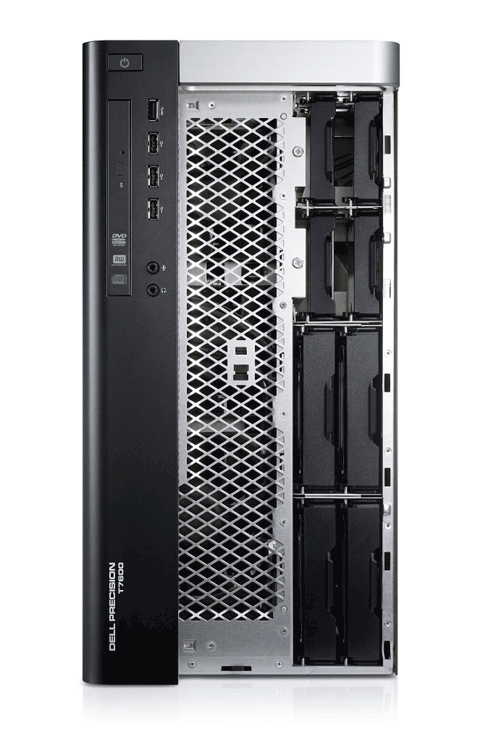
Dell Precision T7600 with front panel removed: Easy access to all eight hard drives (4 x 3.5inch and 4 x 2.5-inch)
Removable power supply
The removable 90% efficient power supply unit (PSU) is a neat feature of all new Precisions. Pulled out directly from the back of the machine, it allows defective units to be replaced in seconds. There are no wires to contend with as these are all connected to the daughter card which sits in the PSU cradle.
Swapping out a traditional power supply usually requires all the hard drives, graphics cards, motherboard, DVD drive etc, to be disconnected first, which can be extremely time consuming.
Dell has also made it easy to diagnose a problem. A built in frosted plastic handle glows green when functioning correctly and changes colour if there is a failure. When the machine is tucked underneath a dark desk, this should even be visible from the front.
It’s likely that most users will never have to use this feature, but for those that manage the IT for large engineering offices, and are likely to keep some PSUs on site, it’ll be a great time saver.
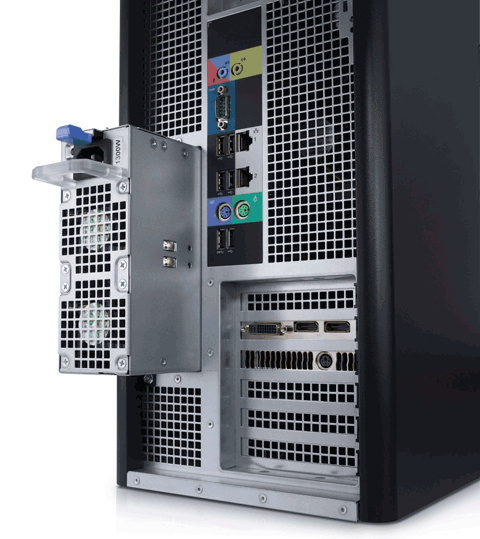
Swapping out a failed power supply on all new Dell Precision workstations can now be done in seconds
Reliable Memory Technology (RMT)
RMT is a Dell patented technology that is claimed to “eliminate virtually all memory errors on high-end workstations.” It works in a similar way to a hard disk drive that has suffered physical damage to the platter. When it detects a non-repairable memory error, it reboots the machine and at a BIOS level prevents the system from writing to the spot again. Typically such errors often lead to the DIMM being replaced, but with RMT Dell reckons it can correct up to 7 errors over the lifetime of the DIMM, minimizing downtime, while keeping the machine stable.
https://youtube.com/watch?v=JpJ30U3erkI
Conclusions
Dell’s new family of Precision workstations is a big step up from its previous generation. The Precision T7500 is not only significantly bigger than the new Precision T7600, but comparatively speaking the layout was chaotic and hard to service.
Everything about the new Precision T7600 is clean, ordered and well considered. It’s clear that a great deal of thought has gone into its design, both from a functional and aesthetic perspective. Indeed, for the first time in the history of the Dell Precision, I can say it looks stylish.
In developing the new chassis Dell sought input from hundreds of firms, but it’s hard to imagine that the original impetus didn’t come as a response to HP’s Z Series following its launch in 2009. This was HP’s bold move to completely re-design the workstation and its tool-less chassis received many plaudits.
While there are many comparisons between the two designs, it’s fair to say that Dell has moved things on a bit with the new Precision. With front and back access to drives and PSU, there’s now little need to remove the side panel during the lifetime of the product. There are also some other neat features such as locating four USB ports at the top front, generously spaced for wider USB drives, and a recess on the top of the machine to stop peripherals sliding off.
Dell was also keen to emphasise, with a subtle reference to its competitors, that the aluminum handles were an integral part of the chassis. This makes them incredibly strong – which is important for portability and essential for those wanting to convert the Precision T7600 to a rack solution (the Dell Precision T7600 can be mounted to any standard Dell PowerEdge server rack and used in conjunction with a Dell Precision FX100 zero client).
In summary, the biggest take away from the new machines is the emphasis on minimizing downtime. However much care goes into a workstation design, they do go wrong over time, with hard drives and PSUs among the biggest culprits. By making these components incredibly easy to swap out Dell is not only helping its customers get up and running in the shortest time frame possible, but minimizing the need for its support team to go on-site – which will in turn save itself money.
In the past swapping out a failed PSU would only be attempted by the most experienced of IT users. Now literally anyone can do it.
At a time when Apple continues to make its products more and more impossible to service or upgrade, it’s refreshing to see the workstation market as a whole is taking big strides in helping users take control of their machines. I wonder if IT geeks, somewhat perversely, will now look forward to a PSU failure.
Driving product development on the Precision T7600 chassis
The new Precision T7600 has been completely designed from the ground up as a workstation. This is unusual for Dell who typically adapts chassis from other products. “Internally the chassis before [Dell Precision T7500] was identical to an XPS of the same period,” says Ken Musgrave, responsible for ‘experience design’ on the new Dell Precision workstations. “Different outsides, identical insides. It was a leveraged chassis.”
Starting with a completely blank slate, one of the key design elements of the new Precision was the front grill (bezel). This is a highly functional element, but also gives the box its identity.
“The main reason the bezel exists is to provide a degree of security to the front of the system, in a sense”, says Musgrave. “What it can’t do is interfere with airflow and it has to also create a degree of appeal and personality to the product. As functional as they are there’s an undeniable emotional component to it as well.
“We spent way too much time trying to get the bezel just right, it’s ridiculous,” he jokes. “They’ve become a little bit like the grills of automobiles.“If you watch Top Gear those guys will just brutalise a grill — it’s an ordinary thing, but they’re obsessing over the grill.”
Designing how this iconic part would look was only the first challenge; the next hurdle was engineering its curved form. It needed to be strong and rigid in order to keep the front-loading hard drives secure (the side panel and front grill can be secured with a single padlock) and give the workstation a feeling of quality.
“We knew what we wanted to accomplish — we wanted this honeycomb kind of design,” explains Musgrave. “We did an extrusion of it and we wrapped it around a corner.
“We weren’t sure if we could do that though — there were a lot of people at Dell that didn’t know if we could do it at all. We did a lot of FEA [Finite Element Analysis] work on this [to make it happen].”
The grill also plays a critical role in thermally managing the interior components. Fans draw air in at the front of the machine — cooling the CPUs, memory and hard drives — before being expelled at the rear. Specially made ducts channel air from individual fans to each memory bank. Computational Fluid Dynamics (CFD) plays a big role in optimising airflow and minimizing fan noise.
The Precision T7600 does not use filters to stop unwanted dust entering the machine through the grill. “Filters are a problem. We do have filters in some areas [of Dell] when there’s a high dust environment,” says Musgrave, “But if they don’t get changed they reduce airflow and will cause more thermal shutdowns and do damage than what they protect. What we’d rather do is have all the particulates just pass all the way through, so we make the holes as big as possible.”
“We have talked about filters multiple times — and we actually have a filter set available on one of our servers — but it’s requiring the IT professionals to stay on top of it [changing them regularly]. Filters inherently reduce airflow immediately and the moment they add dust they go downhill.”
Manufacturing the grill was the final hurdle, “This was one of those products that people said can’t be moulded because there are actions and undercuts rolling around corners,” explains Musgrave adding that Dell made extensive use of mould analysis to solve the problems and take the bezel into production.






